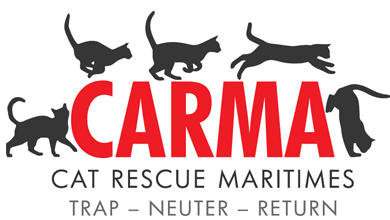Ferals are commonly misunderstood. They are not wild animals, like bobcats or lynx. Instead, feral cats are common domestic cats that differ from pet cats only because they have had little or no positive interaction with humans. They are wary and will resist contact. Kittens born to an abandoned, unsprayed pet will grow up to be feral. However, if brought into human care and socialized at a young age, these kittens will become ordinary household pets, trusting, companionable and able to be handled.
Why can’t ferals be handled through animal shelters?
Cats that grow up feral or abandoned pet cats that acquire feral behaviors are usually poor candidates for successful adoption into homes. Feral cats cannot be picked up or handled. Shelters must use their limited space for adoptable animals. However, if spayed or neutered, ferals can live healthy and contented lives in a supported colony environment.
Why do ferals need help?
Feral cats do not have the necessary skills to fend for themselves and survive without human help. Most ferals live fewer than two or three years in unsupported environments, but by this time have produced many offspring who will also become feral.
What is a cat colony?
A colony is simply a group of free-roaming cats living together. The colony site may be a city street or suburban neighborhood, a farm or rural property, a junk or salvage yard, an industrial site, an empty lot or abandoned building, a municipal garbage dump, a university campus — wherever food (often garbage, rodents) and shelter can be found.
How do cat colonies form?
Feral colonies form wherever homeless or free-roaming cats find food and shelter. Often a kind person or a caring community tries to provide for “strays,” that turn up hungry and in rough shape. A single pregnant female “stray” can turn into a colony of dozens in just two years. Cats become sexually mature between four and five months of age and multiply at an astonishing rate. Feral females usually produce one or two liters of four to six kittens each in their first year of life and then three litters annually.
Compassion is not a sign of mental illness. People who find themselves with a cat colony are rarely “collectors” or “hoarders.” They, like the cats they try to help, are victims of irresponsible, thoughtless and often cruel human behavior.
What is the difference between a feral and a stray cat?
A “stray” cat is most often an abandoned pet, left behind when the family moves or dumped out on a country road because it has become inconvenient or a nuisance — pregnant, spraying or no longer a cute kitten. Many find their way to a cat colony where there is food and shelter. Over time an abandoned pet “stray” may take on feral characteristics. Its offspring will grow up feral.
Ferals live in the shadows, out of sight, coming out at night. A “stray” that turns up in a backyard in broad daylight is unlikely to be truly feral, though it may be fearful and unapproachable. It does, however, need human help. “Strays” that were once a pet can be rehomed through an animal shelter.
Why are there so many feral cats?
Pet owners who fail to spay or neuter their cats and allow them to roam or who abandon unaltered pets to fend for themselves are largely responsible for the feral population. The astonishing rate of reproduction among cats is another factor.
